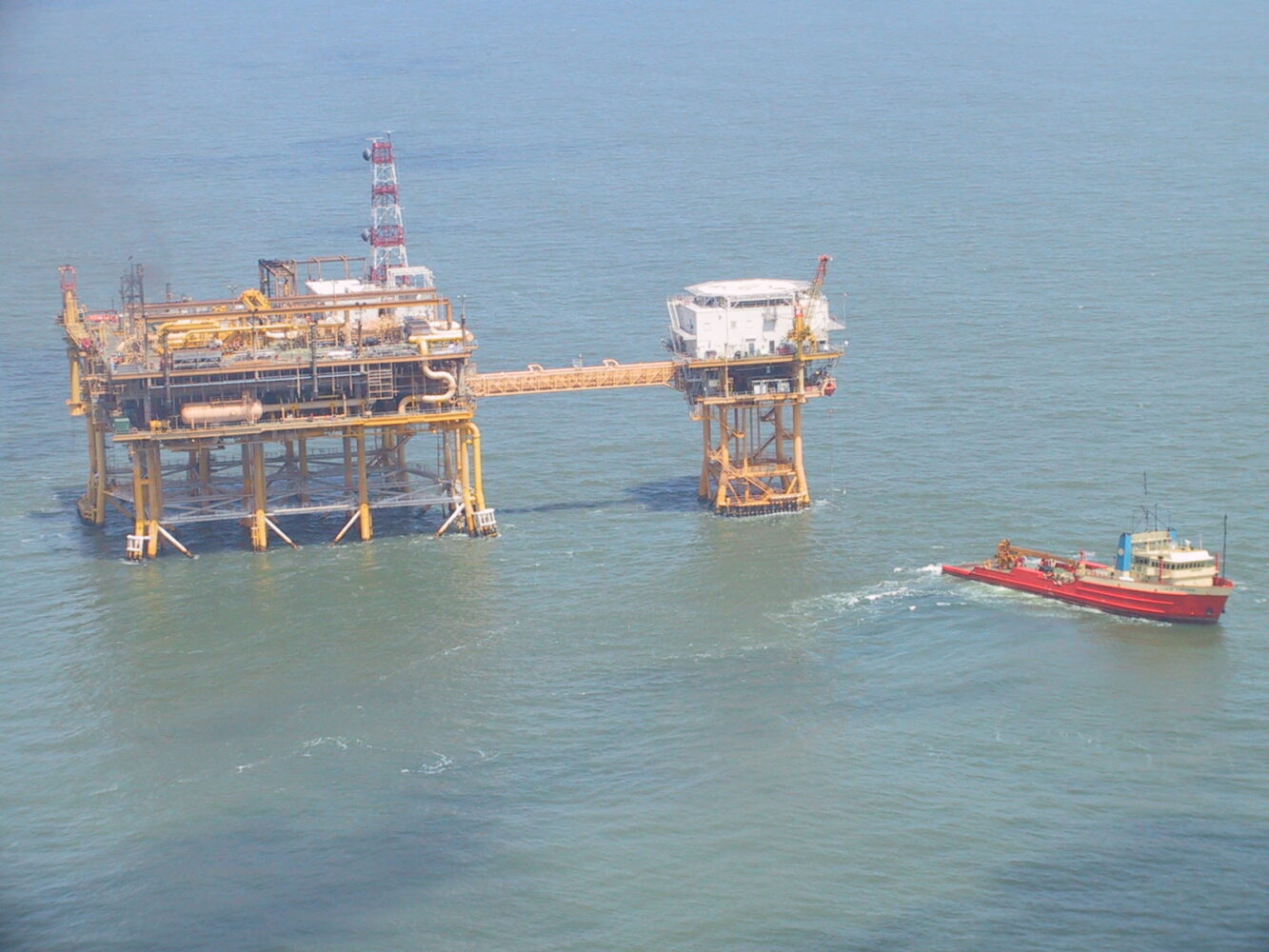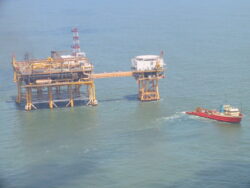Oil and Gas Industry in Louisiana
While the oil and gas industry has helped grow Louisiana’s economy, it has also created significant environmental challenges.
This entry is 8th Grade level View Full Entry

Wikimedia Commons user Edibobb
Louisiana Offshore Oil Port, Pumping Platform Complex.
The oil and gas industry has been a dominant economic force in Louisiana for over a century. All sixty-four parishes in the state have produced oil and gas at some time. Historically, the industry generates about a quarter of the state’s total revenues and provides jobs for tens of thousands of workers. Louisiana is consistently one of the top producers of oil and gas in the nation. The economic benefits from the industry have been important to Louisiana for decades. However, these economic benefits also come with social and environmental costs.
How did the oil and gas industry begin in Louisiana?
The first oil field in Louisiana was discovered by the Heywood brothers in the Evangeline field in Acadia Parish. In 1901 the brothers traveled to the Jennings area to investigate gas seeps in a rice field owned by Jules Clement, a French-speaking farmer. Because the Heywoods had worked in the oil industry in Texas, they knew that gas seeps were signs of oil below the surface. The farmer agreed to let the Heywoods drill two wells at a thousand feet each on his land. They set up the Jennings Oil Company and hired a driller from Texas to do the work. The first well was not successful. They made the risky decision to drill the second well at the bottom of the first well. On September 21, 1901, the drillers hit an oil sand formation and created a “gusher” that blew out oil from the top of the drilling structure. A second successful well drilled next to the first produced seven thousand barrels of oil a day.
Development of the Evangeline oil field, also known as the Jennings field, continued for several years. Production quickly increased to one hundred thousand barrels a day. The Heywoods operated several leases in the field. They built pipelines, storage tanks, and loading racks near a railroad to move the oil to markets. They piped oil onto barges parked near the Mermentau River to be shipped to buyers along Louisiana’s waterways. The oil provided a cheap new fuel source for the region’s growing agriculture industry. Most of the oil was used as fuel for industries that were within a hundred miles of the field.
These early oil men faced many challenges. They battled terrible fires and wasteful gushers. Word of the discovery of oil in the area caused a mad rush of drilling from many competitors, leading to overproduction. The Heywoods responded by storing excess crude production in massive aboveground earthen tanks. These tanks or pits were later used to store salt water, which is a waste product of oil operations. These practices led to negative environmental impacts over the years, such as soil contamination.
The discovery of oil transformed Jennings into a boomtown and the first center for oil in the state. The rush of investors, workers, equipment dealers, and land speculators into the area brought a great deal of wealth to the growing rice-farming town. By the time oil production from the field declined in 1907, it had produced fifty million barrels of oil. The oil, known as “black gold,” made local landowners rich. Jules Clement became a millionaire by today’s standards. Three decades after the historic discovery, the oil and gas business became the state’s main industry.
How has the oil and gas industry changed over time?
The southern region of Louisiana has seen the most oil and gas development in the state. Along the coast and just offshore, hundreds of salt domes are buried deep beneath the surface. Pools of oil were found near these salt domes. By the late 1930s the oil industry had advanced along the coastal plain at a fast pace. Eventually, exploration for oil and gas moved offshore into the Gulf of Mexico.
As the industry expanded into more areas of the state and offshore, oil and gas development stimulated all areas of the economy. To support the industry, infrastructure was built along the coast to store and transport the oil and gas. State and local governments received increased tax revenue from the oil industry to fund their programs and budgets. Hundreds of locally owned companies sprang up throughout South Louisiana to provide support services to oil and gas companies. These companies built barges and boats and supplied the industry with tools and equipment. Other businesses supported the industry by providing catering services to feed workers and warehouses for storage. The benefits of the oil boom spread to all parts of the economy, including banking, real estate, and car sales.
Growing demand after World War II fueled the continued search for new oil and gas supplies. Eventually, exploration extended into the deep waters of the Outer Continental Shelf several miles offshore. In 1947 Kerr-McGee successfully opened the first commercial offshore oil field in the Gulf of Mexico, about ten miles south of Morgan City. Many engineering problems had to be solved for companies to risk investing in exploration this far offshore. But in time, through research, technology, and favorable policies, offshore drilling became successful.
By the end of the 1970s, the industry had built thousands of platforms and miles of pipelines offshore. South Louisiana became the center for development of new oil and natural gas supplies from offshore waters.
What are the benefits and costs associated with the oil and gas industry in Louisiana?
Energy development in Louisiana has come with benefits and costs for the Pelican State. On the one hand, it completely transformed the state’s economy. It provided high-paying jobs and improved the standard of living for thousands. On the other hand, the industry produced unintended and long-lasting environmental impacts. These environmental tradeoffs are an important aspect to the history of oil and gas development in the state.
The oil industry has built thousands of miles of man-made canals in coastal marshes and barrier islands, which have contributed to the state’s coastal erosion problem. Experts also believe that taking fluids from underground has led to subsidence, a form of land collapse. Water and soil have been contaminated by oil spills, saltwater (a by-product of oil) dumped into waterways, and leaks from open oilfield waste pits. Oil pollution has also led to degraded wetlands. Abandoned oil and gas fields often contain old and rusted flowlines, wells, and tank batteries that leak, polluting the surrounding areas. Without effective cleanup and remediation of polluted sites, this contamination will remain in the environment indefinitely.
For many decades the oil and gas industry operated without much oversight or enforcement from the state. Around the 1980s, once these environmental issues became widely known, new attitudes and stricter regulations forced industry practices to change. While environmental protection standards have improved, the industry’s environmental impact throughout the state will endure for decades to come.
Scenes of oil-soaked pelicans and devastated marshlands and beaches became well known during the 2010 Deepwater Horizon oil spill. These images show the real environmental costs that the state dealt with throughout its long history with the oil and gas industry.
